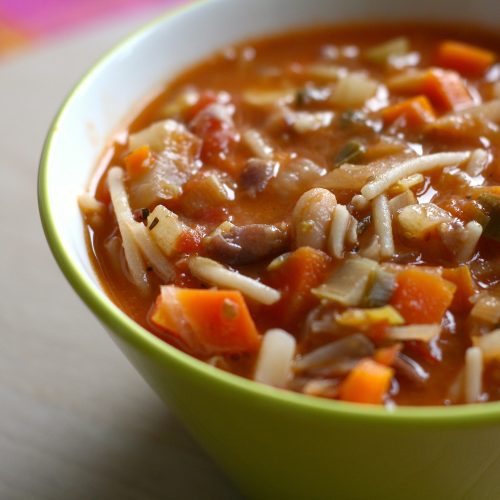
Minestrone Soup
Equipment
- Large pot or Dutch oven
- Cutting board
- Knife
- Measuring cups and spoons
- Stirring spoon
Ingredients
- 2 tablespoons olive oil
- 1 onion diced
- 2 carrots chopped
- 2 celery stalks thinly sliced
- 1 teaspoon sea salt
- Freshly ground black pepper
- 3 garlic cloves minced
- 1 28-ounce can diced tomatoes
- 1 ½ cups cooked cannellini beans drained and rinsed
- 1 cup chopped green beans
- 4 cups vegetable broth
- 2 bay leaves
- 1 teaspoon dried oregano
- 1 teaspoon dried thyme
- ¾ cup small pasta like ditalini
- ½ cup chopped fresh parsley
- Zest and juice of 1 lemon
- Red pepper flakes optional
- Grated Parmesan cheese for serving
Instructions
- Heat olive oil in a large pot over medium heat. Add onion, carrots, and celery and cook until softened.
- Season with salt and pepper, then add garlic and cook for another minute.
- Stir in tomatoes, beans, green beans, broth, bay leaves, oregano, and thyme. Bring to a simmer and cook for 20 minutes.
- Add pasta and cook for an additional 10 minutes until tender.
- Remove bay leaves and stir in parsley, lemon zest, and lemon juice.
- Season with additional salt and pepper, if needed.
- Serve warm, topped with red pepper flakes and grated Parmesan cheese.
Notes
There’s something magical about a day spent in the kitchen, especially when the air outside is cool and crisp. It’s on these days that I find myself reaching for my largest soup pot and filling my home with the warmth and rich aroma of a simmering soup. One recipe I always turn to is minestrone. For me, it’s more than just a meal—it’s an experience, a ritual that brings comfort, warmth, and nourishment to both the body and soul.
I remember the first time I made minestrone soup; it was after a long, chilly day spent outdoors with friends. We had been apple-picking at a nearby orchard, and by the time we returned home, we were exhausted, our hands cold from the fall air. I wanted to make something that would warm everyone up from the inside out, something filling but still light enough to feel fresh. That’s when I thought of minestrone. I’d never made it before, but the idea of a hearty, vegetable-packed soup sounded like the perfect choice. Little did I know, it would become a staple in my kitchen for years to come.
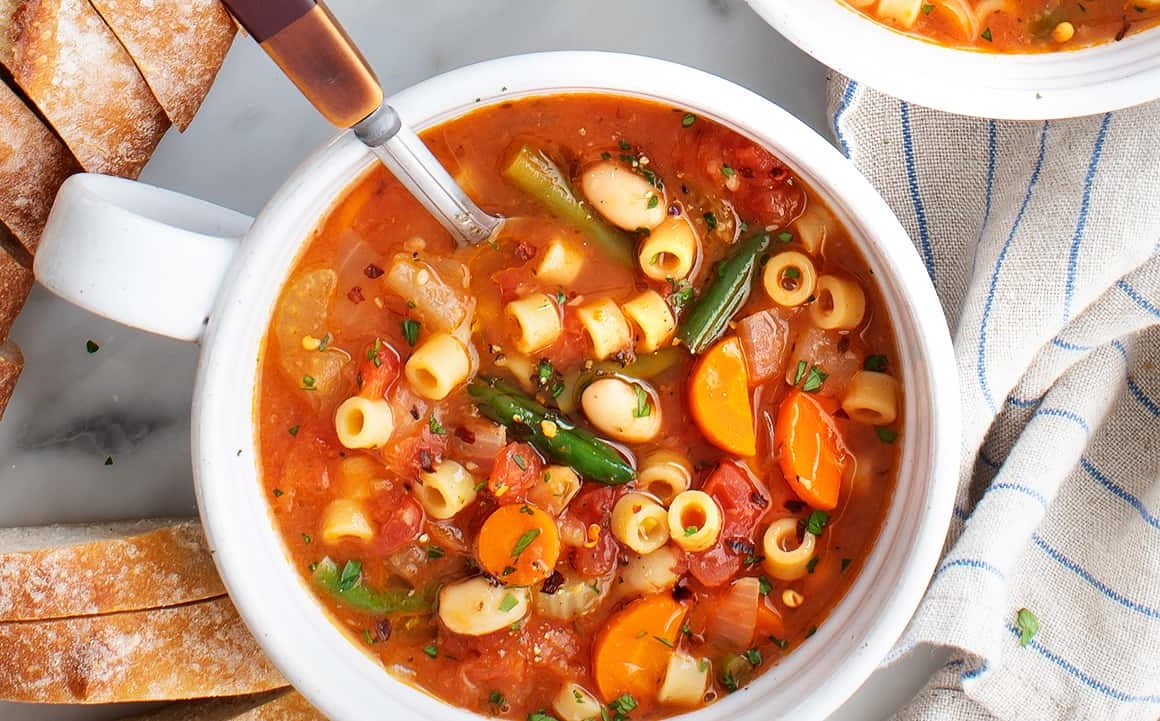
The Heart and Soul of Minestrone Soup
What I love most about this recipe is its versatility and simplicity. Minestrone soup is a dish that feels like a warm embrace; it’s humble yet robust, wholesome yet indulgent in its own way. Every time I make it, I’m reminded of how the simplest ingredients can come together to create something deeply satisfying.
The base of the soup is always the same—a classic Italian soffritto of onions, carrots, and celery. These three vegetables form the backbone of the soup, sautéed slowly in olive oil until they become fragrant and soft. When I’m chopping them, I always smile because the smell that fills the kitchen takes me back to that first pot of minestrone I made after that chilly day at the orchard.
Garlic comes next, stirred in just long enough to release its aroma but not so long that it burns. This step is crucial because garlic has a way of bringing all the flavors together, adding depth and a touch of warmth to the soup. Then come the tomatoes, which add sweetness and a vibrant red color to the broth. I usually use diced tomatoes from a can, but during the summer, when fresh Roma tomatoes are at their peak, I love to chop those up instead. The freshness is unbeatable.
Beans, Pasta, and a Dash of Creativity
What makes minestrone so special is how customizable it is. Over the years, I’ve played around with the ingredients depending on what’s in season or what I happen to have in my pantry. For the beans, I typically use white beans or kidney beans, but I’ve tried everything from navy beans to black beans, and they all work wonderfully. The beans add creaminess and a hearty texture that makes the soup feel substantial enough to stand on its own as a meal.
Green beans are a staple in my version of the soup, adding both texture and color. However, there have been times when I’ve run out of green beans and had to improvise with zucchini or even yellow squash. Both of those substitutions work just as well and bring a new dimension to the soup. The beauty of minestrone is that there are no hard rules—if you’ve got vegetables in your fridge that need using, they can almost certainly find a home in this soup.
One thing I never skip, though, is the pasta. Small pasta shapes like elbows, shells, or orecchiette are perfect for this dish. I cook them right in the soup, allowing them to absorb the flavors of the broth as they soften. There’s something so comforting about the way the pasta thickens the soup, turning it into a meal that’s as nourishing as it is delicious. When I’m feeling extra hungry, I might even toss in some cooked farro or barley for an added boost of texture and flavor.
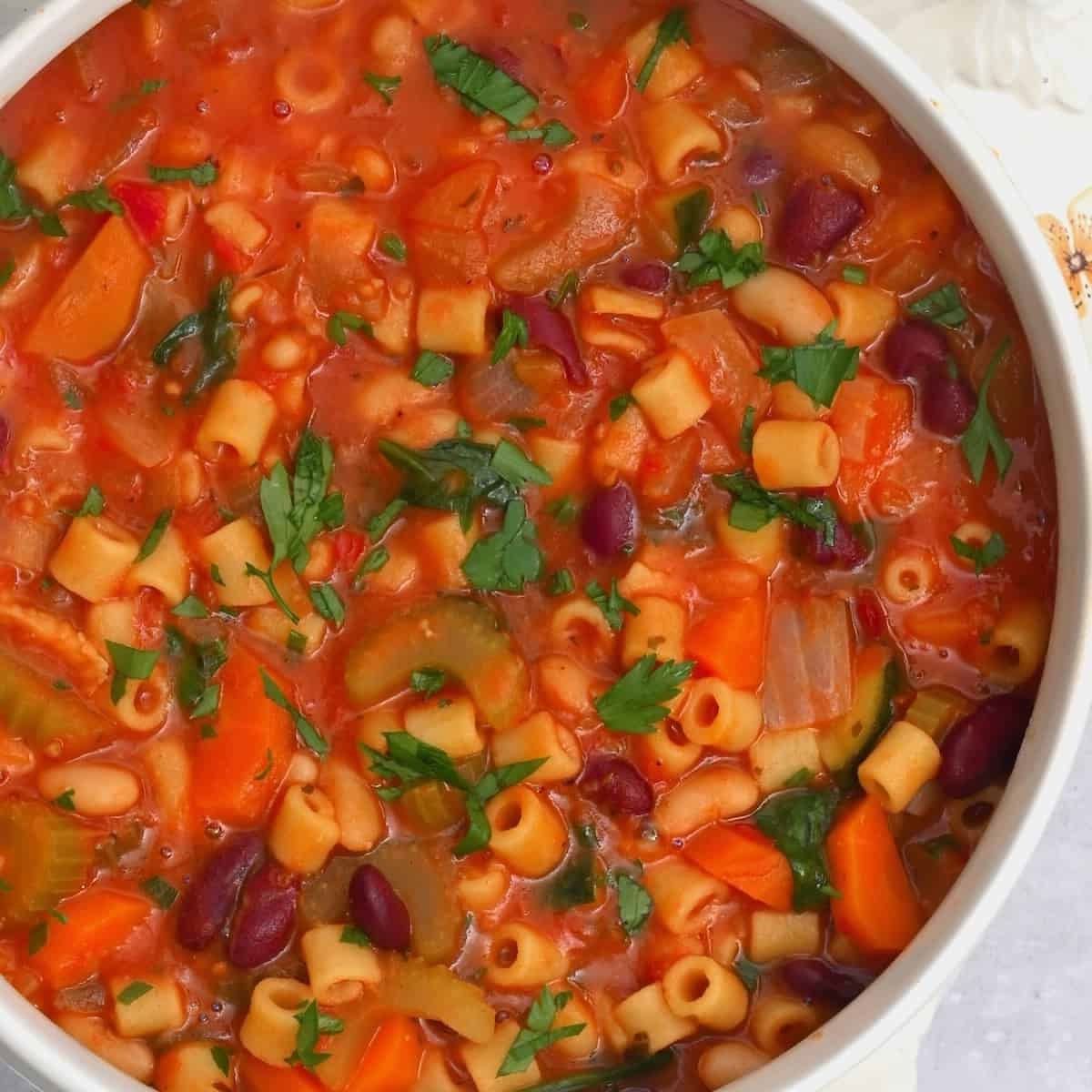
Adding My Own Personal Touches
Over the years, I’ve made this recipe my own in small ways. Sometimes, I add a pinch of red pepper flakes to give the soup a subtle heat that contrasts beautifully with the sweetness of the tomatoes and carrots. Other times, I’ll stir in a handful of spinach or kale toward the end of the cooking process. The greens wilt just enough to meld with the other ingredients, and I love the pop of color and nutrition they bring to the table.
One of my favorite variations is to use homemade vegetable broth. Whenever I have extra vegetable scraps from cooking, I save them to make broth, and using it in this soup takes the flavor to the next level. If you’ve never made your own broth, I highly recommend it. It’s a simple way to reduce waste and infuse your dishes with even more depth and complexity.
Serving the Soup: The Best Part
For me, serving minestrone is the best part of the whole process. After spending an hour or so letting the soup simmer, the reward is a steaming bowl that’s packed with flavor. I always finish each bowl with a sprinkle of fresh parsley, a generous handful of grated Parmesan, and a dash of red pepper flakes (if I’m feeling adventurous). If I’m lucky enough to have a loaf of crusty bread on hand, I slice it thick, toast it lightly, and serve it alongside the soup for dipping. There’s nothing quite like tearing off a piece of warm, crusty bread and soaking up the flavorful broth.
And when I’m feeling indulgent, I’ll sneak in a drizzle of good-quality olive oil on top, or sometimes I’ll add a spoonful of pesto. Pesto may not be traditional, but trust me—it takes the soup to a whole new level of deliciousness. The basil and garlic in the pesto pair so well with the tomato and herb base of the soup, making every bite a little more exciting.
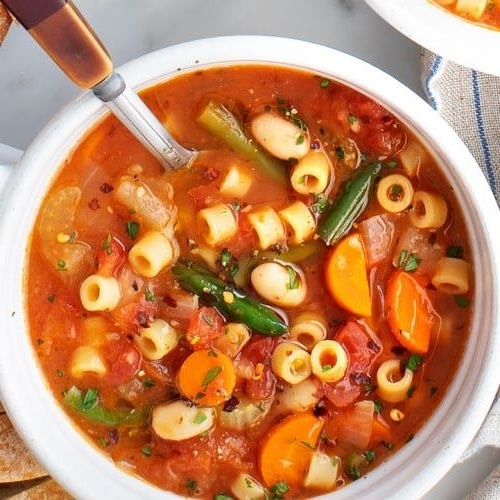
Recipe Rhapsody: Three Minestrone Masterpieces
Sunshine Minestrone (Inspired by Love and Lemons)
Ingredients:
- 2 tablespoons olive oil
- 1 onion, diced
- 2 carrots, chopped
- 2 celery stalks, thinly sliced
- 1 teaspoon sea salt
- Freshly ground black pepper
- 3 garlic cloves, minced
- 1 (28-ounce) can diced tomatoes
- 1 ½ cups cooked cannellini beans, drained and rinsed
- 1 cup chopped green beans
- 4 cups vegetable broth
- 2 bay leaves
- 1 teaspoon dried oregano
- 1 teaspoon dried thyme
- ¾ cup small pasta (like ditalini)
- ½ cup chopped fresh parsley
- Zest and juice of 1 lemon
- Red pepper flakes
- Grated Parmesan cheese, for serving
Instructions:
- Heat olive oil in a large pot over medium heat. Add onion, carrots, and celery and cook until softened.
- Season with salt and pepper, then add garlic and cook for another minute.
- Stir in tomatoes, beans, green beans, broth, bay leaves, oregano, and thyme. Bring to a simmer and cook for 20 minutes.
- Add pasta and cook for an additional 10 minutes until tender.
- Remove bay leaves and stir in parsley, lemon zest, and lemon juice.
- Season with additional salt and pepper, if needed.
- Serve topped with red pepper flakes and grated Parmesan cheese.
Classic Comfort Minestrone (Inspired by Cookie and Kate)
Ingredients:
- 2 tablespoons olive oil
- 1 onion, chopped
- 2 carrots, chopped
- 3 celery stalks, chopped
- 4 cloves garlic, minced
- 1 teaspoon dried oregano
- 1/2 teaspoon dried thyme
- 1/4 teaspoon red pepper flakes
- 1 (28-ounce) can diced tomatoes
- 6 cups vegetable broth
- 1 cup dried cannellini beans, soaked overnight and drained
- 1 bay leaf
- 4 cups chopped kale
- 1/2 cup small pasta (like ditalini)
- 1/4 cup chopped fresh basil
- 1/4 cup grated Parmesan cheese
- Salt and pepper to taste
Instructions:
- Heat olive oil in a large pot over medium heat. Add onion, carrots, and celery and cook until softened.
- Add garlic, oregano, thyme, and red pepper flakes. Cook for 1 minute more.
- Add tomatoes, broth, beans, and bay leaf. Bring to a boil, then reduce heat and simmer for 1 hour, or until beans are tender.
- Stir in kale and pasta. Simmer for another 10-15 minutes, until pasta is cooked through and kale is tender.
- Remove bay leaf and stir in basil and Parmesan cheese. Season with salt and pepper.
- Serve warm.
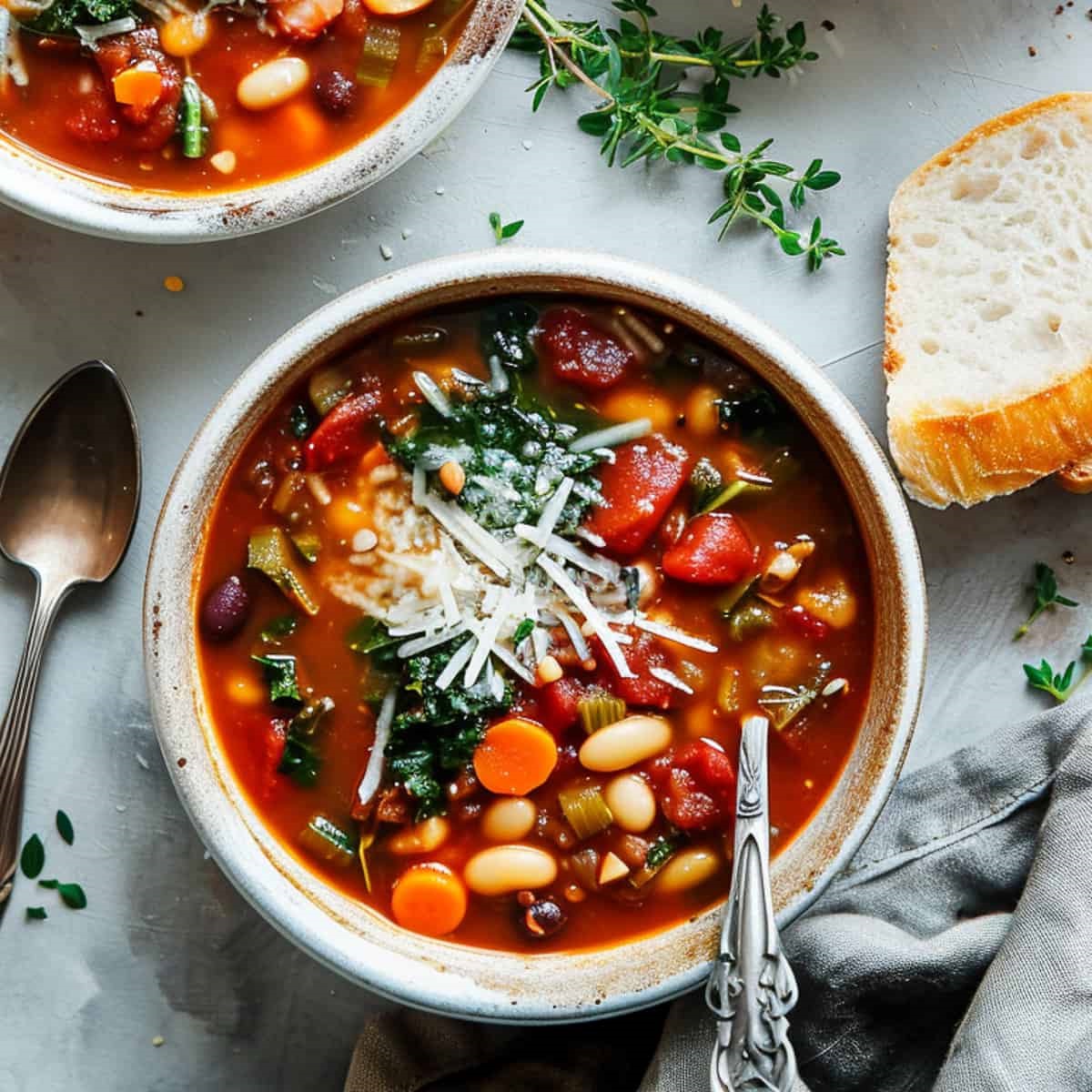
Rustic Italian Minestrone (Inspired by Jamie Oliver)
Ingredients:
- 3 tablespoons olive oil
- 3 cloves garlic, chopped
- 2 onions, chopped
- 2 cups chopped celery
- 5 carrots, sliced
- 4 cups tomato sauce
- 2 cups chicken or vegetable broth
- 2 cups water
- 1/2 cup red wine (optional)
- 3 zucchini, quartered and sliced
- 2 cups baby spinach
- 2 cups green beans, trimmed and cut into 1-inch pieces
- 1 cup canned kidney beans, drained
- 2 tablespoons chopped fresh basil
- 1 tablespoon chopped fresh oregano
- Salt and pepper to taste
- 1/2 cup small pasta (like ditalini)
- 2 tablespoons grated Parmesan cheese
Instructions:
- Heat olive oil in a large pot over medium heat. Sauté garlic, onions, celery, and carrots until softened.
- Add tomato sauce, broth, water, and red wine (if using). Bring to a boil, then reduce heat and simmer for 15 minutes.
- Add zucchini, spinach, green beans, and kidney beans. Simmer for another 30 minutes.
- Stir in basil, oregano, salt, and pepper.
- Add pasta and cook until tender, about 10 minutes.
- Serve warm, topped with Parmesan cheese.
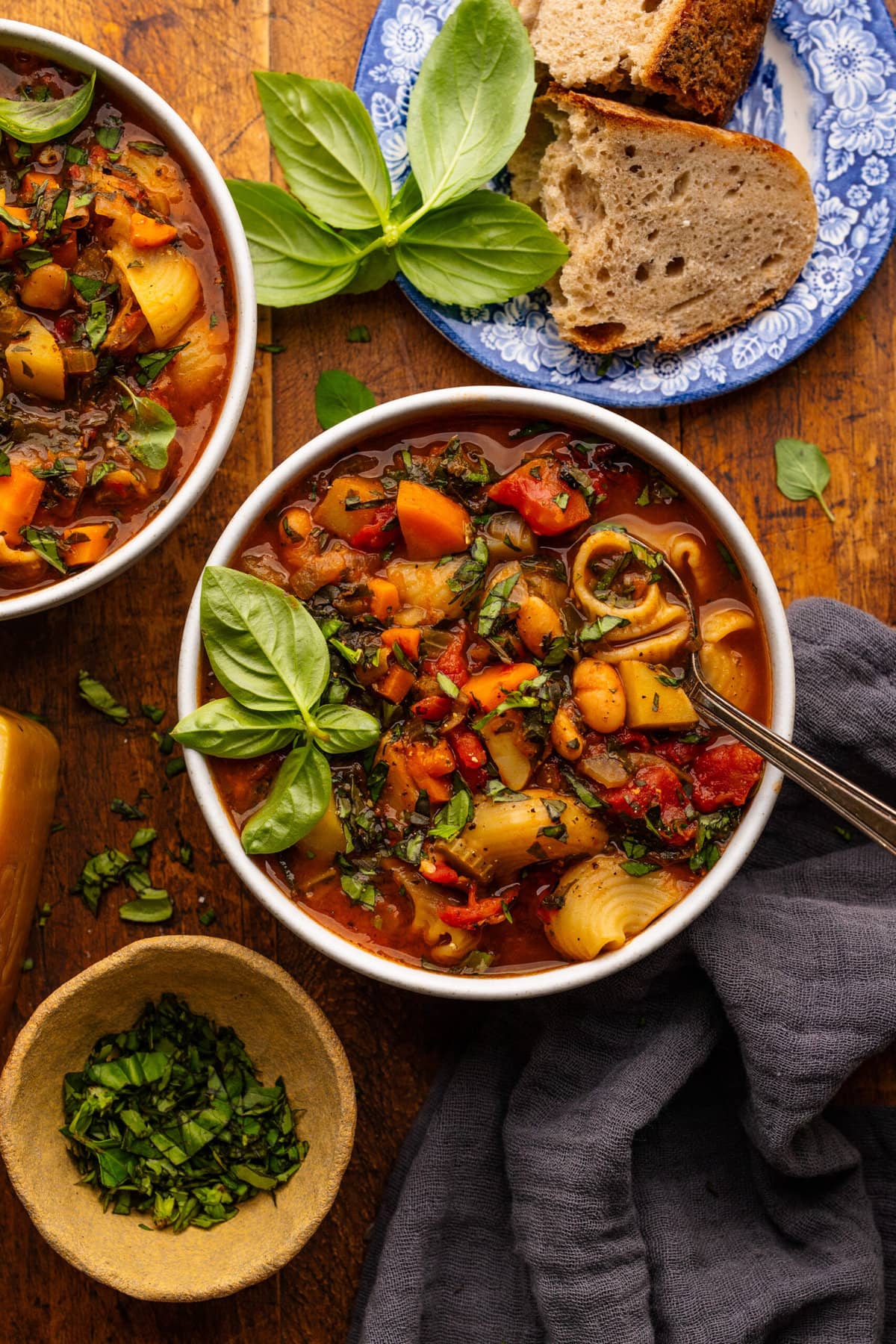
Leftovers: The Gift that Keeps on Giving
One of the best things about minestrone soup is that it makes for excellent leftovers. In fact, I think the flavors improve as they sit, blending together in perfect harmony by the next day. If I’m planning to enjoy the soup over several days, I’ll sometimes cook the pasta separately and add it in when I reheat the soup. That way, it doesn’t absorb too much broth and get overly soft.
And if you’re like me and enjoy having meals ready to go in the freezer, minestrone soup freezes beautifully. I like to portion it out into individual containers, so I can grab a serving whenever I need a quick, comforting lunch or dinner.
Make It Yours
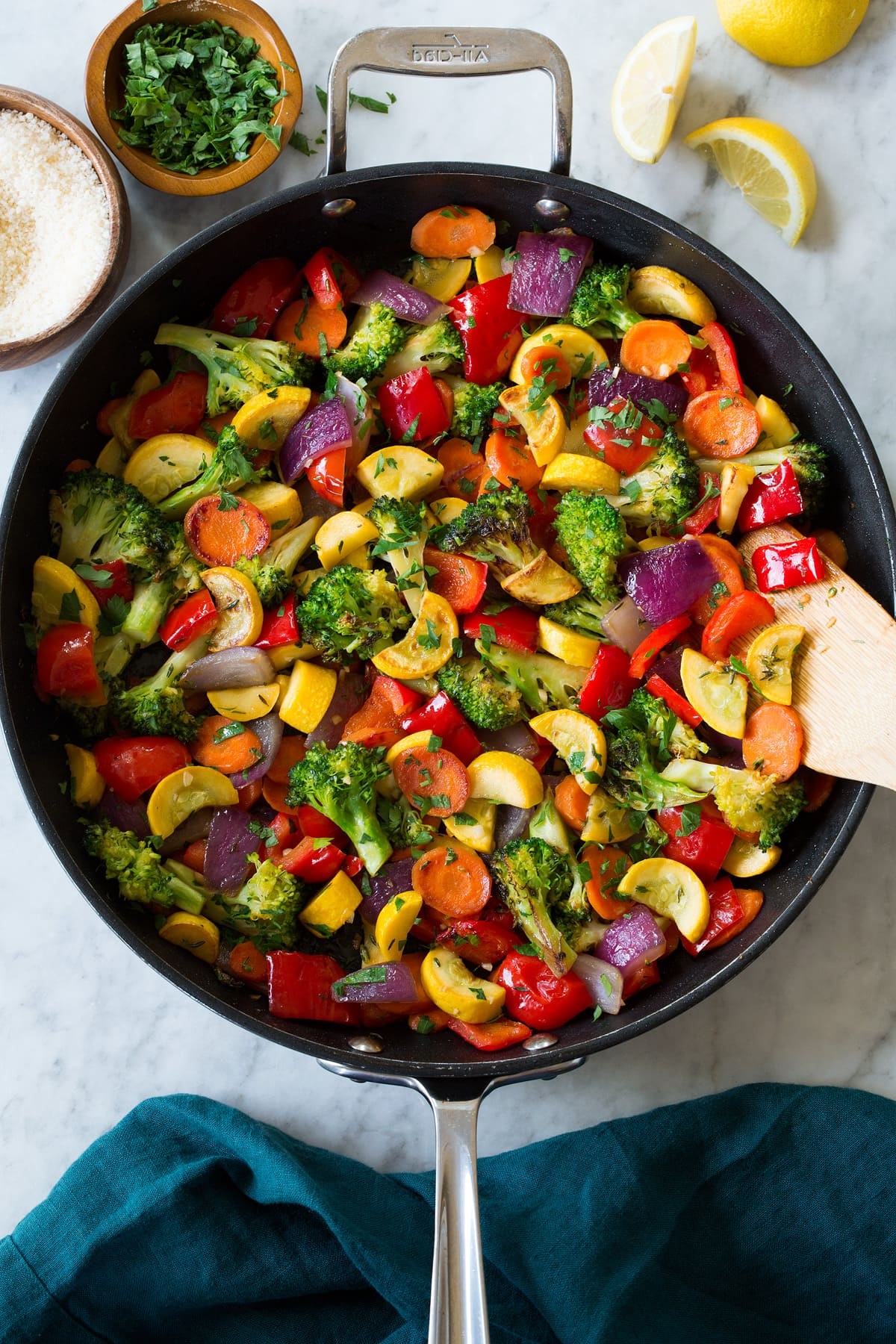
At the end of the day, minestrone soup is all about flexibility and creativity. Whether you follow the recipe exactly or use it as a blueprint to create your own version, you really can’t go wrong. It’s the kind of dish that invites you to experiment, to try new things, and to enjoy the process of cooking. I hope that when you make this soup, you find the same comfort and joy that I do—and maybe, just maybe, it’ll become a favorite in your home, too.

Hello, I’m Elaria Jackson, the author behind Vegan Castle. I have a background in Nutrition Science and Culinary Arts. I’ve studied the benefits of a plant-based diet and its impact on health and the environment. I’ve attended various vegan cooking courses and workshops. Through Vegan Castle, I share easy weeknight meals and decadent desserts. I aim to be a valuable companion on your vegan journey.

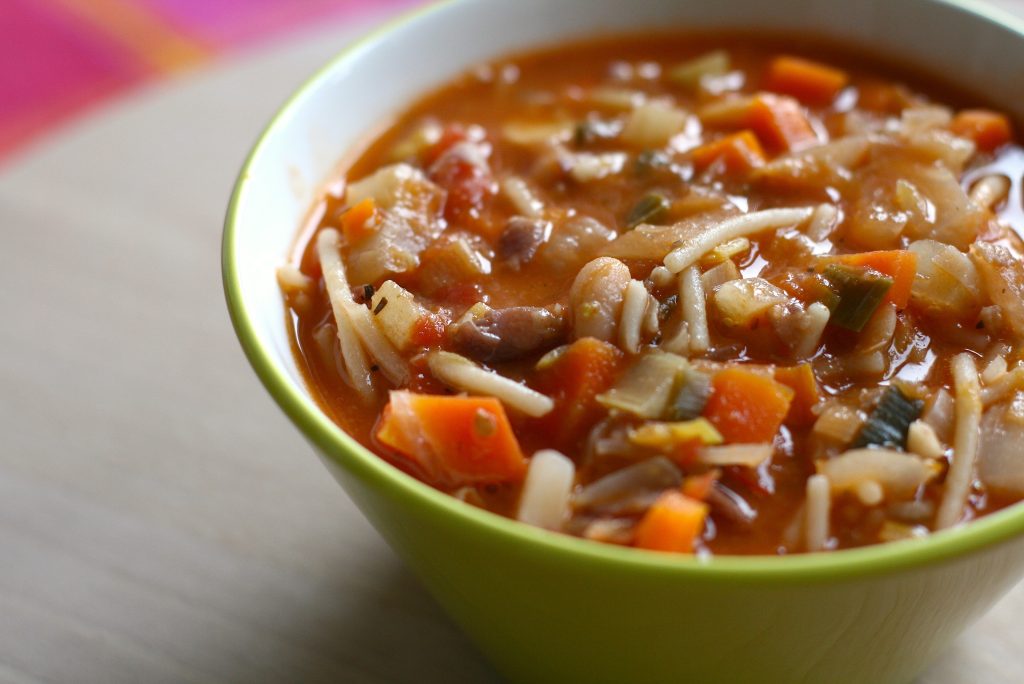
This soup looks perfect for meal prepping. Can it be frozen, or is it better to eat fresh? I’d love to make a big batch.
Hi Laura! This minestrone soup freezes really well. Just let it cool completely before freezing. It’s great for meal prepping. Enjoy!
Tried this minestrone soup recipe, and it was fantastic! I added some red pepper flakes for a bit of heat, and it was just what I needed on a cold night. Thanks!
Hi Chris! Red pepper flakes for some heat sound perfect, especially on a cold night. Glad you enjoyed the recipe. Thanks for the feedback!